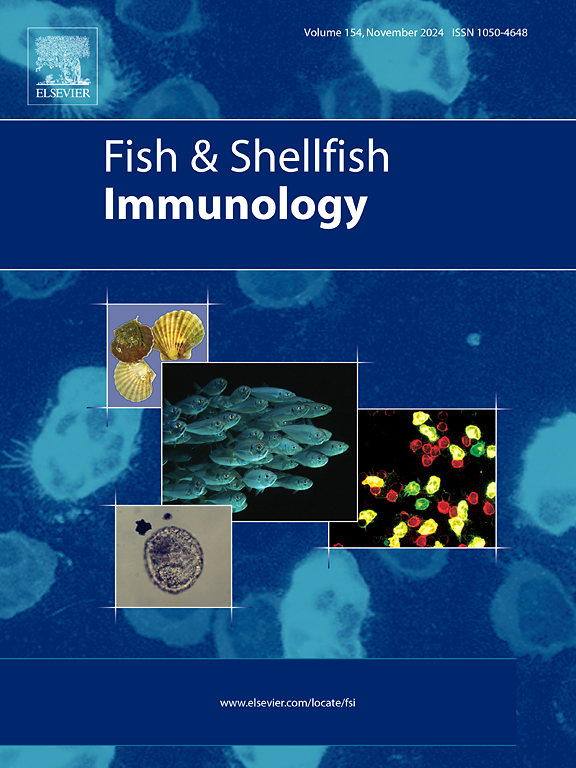Three hepcidins from the spotted knifejaw (Oplegnathus punctatus) promote antimicrobial activity via TLR/NFκB pathway
IF 4.1
2区 农林科学
Q1 FISHERIES
引用次数: 0
Abstract
Hepcidin belongs to a class of small cationic antimicrobial peptides rich in cysteine. It is synthesized by liver and is widely involved in host antimicrobial, antiviral and other immune responses. We identified and characterized three hepcidin genes (OpHep1, OpHep2 and OpHep3) in spotted knifejaw. All the OpHeps shared high identities with hepcidins in other teleost, containing alpha helix and β-sheets. Three OpHeps were all detected in healthy tissues, with the abundant expression in liver. They were significantly increased after Vibrio harveyi infection in the six immune-relevant tissues (liver, kidney, spleen, gill, skin and intestine). OpHeps knockdown in spotted knifejaw liver cells affected the mRNA levels of inflammation-related genes, including il1β, il6, il8, and nfκb. Further, the recombinant hepcidin proteins were effective in suppressing the growth of both Gram-negative and Gram-positive bacteria. To identify the function of OpHeps in vivo, we performed the overexpression of three OpHeps in zebrafish, and found OpHeps could significantly induce immune-related genes expression in transgenic zebrafish, including myd88, il10, il21, il16, tlr1, tlr3 and lysozyme. When infected with V. harveyi, OpHeps transgenic zebrafishes had a higher survival rate than wild-type zebrafishes. The expression of myd88, il10, il8, il1β, nfκb and lysozyme were all significantly up-regulated in transgenic fishes during bacterial infection. In summary, these results indicated that hepcidin could protect fish fight against pathogen through TLR/NFκB signaling cascade and Lysozyme. Three OpHeps would be potential targets for prevention of bacterial infections in aquaculture industry of spotted knifejaw, which provided a new idea for the molecular breeding of fish disease resistance.
斑刀鱼(Oplegnathus punctatus)的三种血红素通过 TLR/NFκB 途径促进抗菌活性
肝素属于一类富含半胱氨酸的小型阳离子抗菌肽。它由肝脏合成,广泛参与宿主的抗菌、抗病毒和其他免疫反应。我们发现并鉴定了斑点叉尾鮰的三个肝素基因(OpHep1、OpHep2和OpHep3)。所有OpHeps都与其他鱼类的血球素有很高的相似性,含有α螺旋和β片。三种 OpHeps 都在健康组织中被检测到,其中在肝脏中的表达量最大。感染 Harveyi弧菌后,它们在六个免疫相关组织(肝、肾、脾、鳃、皮肤和肠)中的表达明显增加。在斑刀鱼肝细胞中敲除 OpHeps 会影响炎症相关基因的 mRNA 水平,包括 il1β、il6、il8 和 nfκb。此外,重组肝磷脂蛋白还能有效抑制革兰氏阴性菌和革兰氏阳性菌的生长。为了确定OpHeps在体内的功能,我们在斑马鱼体内过表达了三种OpHeps,发现OpHeps能显著诱导转基因斑马鱼体内免疫相关基因的表达,包括myd88、il10、il21、il16、tlr1、tlr3和溶菌酶。在感染 V. harveyi 后,OpHeps 转基因斑马鱼的存活率高于野生型斑马鱼。在细菌感染过程中,转基因鱼体内的myd88、il10、il8、il1β、nfκb和溶菌酶的表达均显著上调。综上所述,这些结果表明,肝素可通过TLR/NFκB信号级联和溶菌酶保护鱼类抵抗病原体。三种OpHeps将成为预防斑点叉尾鮰养殖业细菌感染的潜在靶标,这为鱼类抗病分子育种提供了新思路。
本文章由计算机程序翻译,如有差异,请以英文原文为准。
求助全文
约1分钟内获得全文
求助全文
来源期刊

Fish & shellfish immunology
农林科学-海洋与淡水生物学
CiteScore
7.50
自引率
19.10%
发文量
750
审稿时长
68 days
期刊介绍:
Fish and Shellfish Immunology rapidly publishes high-quality, peer-refereed contributions in the expanding fields of fish and shellfish immunology. It presents studies on the basic mechanisms of both the specific and non-specific defense systems, the cells, tissues, and humoral factors involved, their dependence on environmental and intrinsic factors, response to pathogens, response to vaccination, and applied studies on the development of specific vaccines for use in the aquaculture industry.
 求助内容:
求助内容: 应助结果提醒方式:
应助结果提醒方式:


